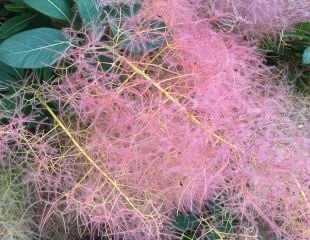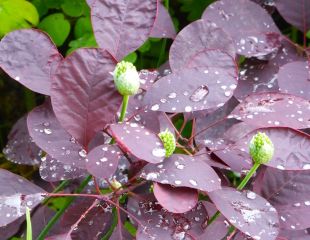
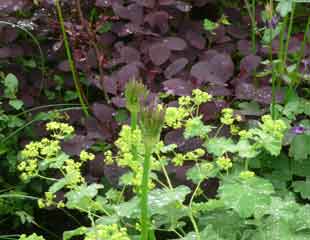
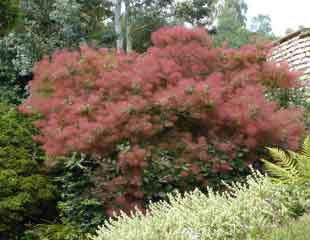
Cotinus coggygria "The Smoke Bush"
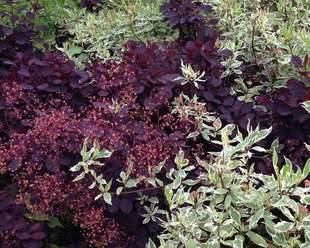
Cotinus Coggygria is an easy to grow deciduous shrub which has lovely coloured foliage which colours well in the autumn. When Cotinus flowers, the shrub takes on the appearance of being wreathed in smoke, which accounts for its common name, the Smoke bush.
Cotinus will grow in most soils and will tolerate partial shade. Partial shade is better suited to the green-leaved varieties, as opposed to purple and red, which require more sun. There are several varieties of the Cotinus coggygria illustrated above in the centre C 'Royal purple' image left and centre which has lovely purple foliage. Cotinus 'Royal purple' with its purple leaves creates contrast in the border, as in the image right with Alchemilla mollis (Lady's mantle) making a good border combination.
Cotinus coggygria have strong autumn colour, especially 'Flame' and 'Grace'. The image left shows Cotinus planted alongside Cornus and the contrast is attractive, well worth planting as part of a shrub border. Cotinus matures into a large shrub as the image above right displays and it is best to check the label for overall size to ensure you have space in the border.
How to Grow Cotinus coggygria The Smoke Bush
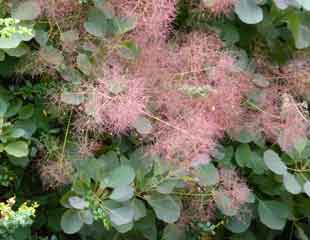
To achieve the strongest colour and the best smokey plumes, Cotinus needs a warm sunny spot. It will grow in partial shade and in most garden conditions, but if those conditions are shady, you may have to be content with the colourful leaves and not too much smoke.
When choosing a Cotinus to plant in the garden, it is good to remember Cotinus can grow quite large. The image above the right shows a Cotinus with full smoke effect and it is a large shrub, almost a small tree. Cotinus Coggygria will grow to around 5ms, 'Flame' and 'Grace' around 6ms which size they will reach in between 10-20years.

This is a close up of Cotinus 'Grace' taken in July when the plant produces the smokey effect, and it looks really effective.
When choosing a Cotinus to plant in the garden, it is good to remember Cotinus can grow quite large. The image above the right shows a Cotinus with full smoke effect and it is a large shrub, almost a small tree. Cotinus Coggygria will grow to around 5ms, 'Flame' and 'Grace' around 6ms which size they will reach in between 10-20 years.
How to Prune Cotinus
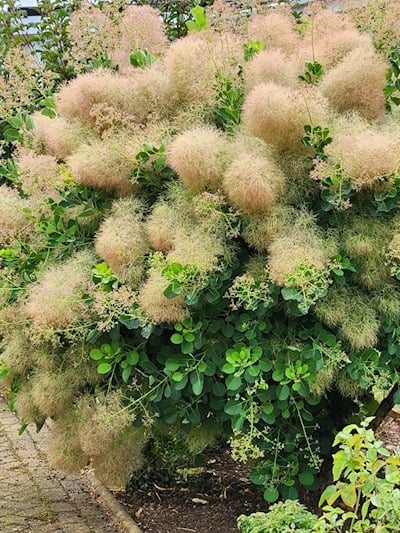
Cotinus requires little or no pruning, which makes it easy to grow. If pruning is necessary, prune Cotinus in late winter or early spring, while dormant to keep its framework attractive. A light prune to remove diseased, spindly or crossing branches. Equally, Cotinus can be left for several years with little or no attention.
Cotinus, when grown in its preferred conditions, can be vigorous and get large. This means it may outgrows it allotted spot or is overshadowing neighbouring shrubs and plants. If this occurs, Cotinus can be hard pruned if the shrub is mature and it will tolerate being cut back hard or coppiced and this will keep it in check, although at the expense of flowers for that year. Hard pruning will also have the effect of producing larger leaves that year.
Cotinus will respond well to clipping and I have seen it grown to a good effect clipped into a round lollipop shape, which makes a nice change from green topiary. I took this image of a Cotinus because it is a good example of how Cotinus can be contained by hard pruning. This cotinus has been every effectively pruning into a round shape and now that it is smoking, it looks like a puffball.
A positive about growing Cotinus is its brilliant autumn colour. Cotinus looks good with many border plants, blue and pink Clematis, with vibrant greens, as in the image centre which is with Alchemilla mollis, and with strong blues such as Agapanthus and good with Crocosmia; and also with other garden shrubs by way of contrast as in image top left with Cornus.
The new foliage in spring looks lovely and particularly beautiful with raindrops on it. Late summer, the shrub, if provided with enough warmth and sun, will flower producing the delicate smoke effect and then put on a spectacular autumn colour; a great garden shrub.
Crocus has 5 varieties of Cotinus for sale, including the lovely rosy red C' Ruby Glow'
Good Cotinus for Autumn Colour
Cotinus flame
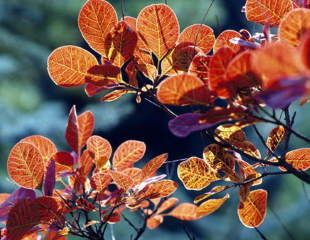
This Cotinus has strong orange coloured leaves which stand out in their autumn colour
Cotinus Coggyria Royal Purple
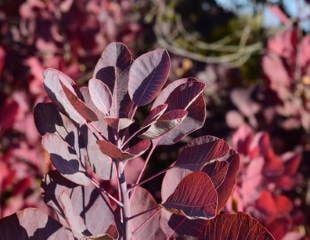
A good colour all year round in the autumn, the purple leaf colour intensifies
Dazzling autumn colour
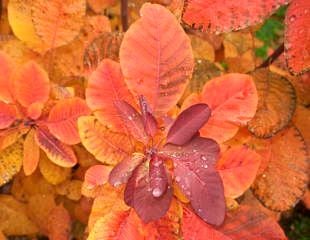
Cotinus produces wonderful strong autumn colours
Cotinus growing wild in Greece
Cotinus Coggygria is native to rocky habitats from the Mediterranean to China. It is always a thrill to see a plant or shrub growing wild in its natural habitat. Driving around a mountainous area in Greece, I came to a stop to admire Cotinus perched on the edge of the road, growing in scrubby ground and wreathed in "Smoke".
It was growing out of the side of a steep cliff, which made getting an image difficult, and so it is not the best. It did look fantastic growing wild and on such a rocky outcrop.




